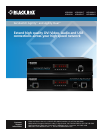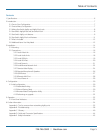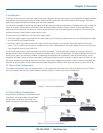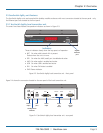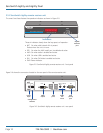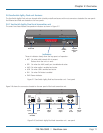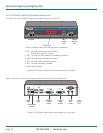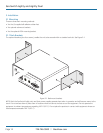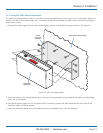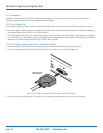
Chapter 2: Overview
724-746-5500 | blackbox.com
Page 7
2. Introduction
Thank you for choosing the ServSwitch Agility range which represents a major advancement in the capabilities of digital extenders
and switches. By encoding high quality DVI video, audio and USB connections into Internet Protocol (IP) messages, ServSwitch
Agility offers highly advanced and flexible signal switching capabilities.
Our extensive knowledge of interfacing techniques and high speed networking has allowed us to develop new ways to break the
chains of local DVI, USB and audio connections. With ServSwitch Agility, distance is finally no barrier to high specification and
high performance computing. Furthermore, since all signals are now IP, the most elaborate and yet simple-to-use switching and
multicast techniques make possible a great variety of uses.
There are two main models within the ServSwitch Agility family:
• ServSwitchAgilitysupportsonesinglelinkDVIvideostream,plusmicrophone,speakersanduptofourUSBperipherals.Agility
units are linked using Gigabit Ethernet.
• ServSwitchAgilityDualsupportseithertwosinglelinkDVIvideostreamsoroneduallink(veryhighresolution)DVIvideo
stream. This is in addition to microphone, speakers and up to four USB peripherals. ServSwitch Agility Dual units can be linked
using Gigabit Ethernet or Fiber Optic Links.
In both model types, there is a Local transmitter and an Remote receiver. The Local transmitter attaches to a single computer; the
Remote receiver to your DVI video monitor, microphone, speakers and up to four USB peripherals. The distance between them is limit-
ed only by the size of your network. In addition to separating one computer and its peripherals, Agility promotes sharing. You can
arrange for a limitless number of screens and speakers, distributed anywhere across the network, to receive video and audio. You can
also switch between any number of transmitter units from a single screen, keyboard and mouse in order to monitor a potentially vast
collection of remote systems. All units feature browser-based configuration utilities to allow quick and easy set up, from near or far.
2.1 One-to-One Configuration
The simplest configuration links one remote receiver unit to a single local transmitter unit, either by a direct link (up to 100m) or
over much greater distances via a Gigabit Ethernet network. Figure 2-1 shows a one-to-one configuration:
Figure 2-1. One-to-one configuration
2.2 One-to-Many Configuration
Using multicast techniques, an unlimited number
of receivers* can receive video and audio data
streams from a single local transmitter unit.
Figure 2-2 shows a one-to-many configuration:
Figure 2-2. One-to-many configuration



